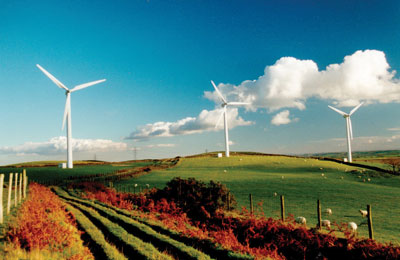
UK on track to hit 2020 green energy targets
London, December 27, 2012
The UK is on track to meet its 2020 renewable energy targets after low-carbon electricity generation grew more than a quarter in the year to end-June 2012, thanks largely to new solar and offshore wind projects, a government report said.
The Department of Energy and Climate Change (Decc) said renewable energy accounted for over 10 per cent of total electricity supplied in the 12 months to end-June.
Renewable power output grew 27 per cent from July 2011, according to the UK's latest Renewable Energy Roadmap status report released on Thursday.
"Renewable energy is increasingly powering the UK's grid, and the economy too," Energy Secretary Edward Davey, who heads Decc, said in a statement that accompanied the report.
"It's a fantastic achievement that more than 10 per cent of our power now comes from renewables, given the point from which we started," he said.
Britain has a target to produce 15 per cent of its energy, including electricity, heat and transport, from renewable sources by 2020 in a bid to cut climate-warming emissions.
This means that 30 per cent of the UK's electricity must come from renewables by the end of the decade, the government said, with wind playing a leading role.
"Right now, getting new infrastructure investment into the economy is crucial to driving growth and supporting jobs across the country... I am determined that we get ahead in the global race on renewables and build on the big-money investments we've seen this year," Davey said.
Decc has identified around 12.7 billion pounds ($20.6 billion) of confirmed and planned renewable investment by companies between April 1, 2011 and July 31, 2012, potentially creating around 22,800 jobs.
The department, which expects the growth in renewables to continue or accelerate, predicts the industry will support 400,000 direct jobs by 2020, up from around 110,000 jobs currently.
Government subsidies have played a key role in encouraging investment, however, and economic difficulties have put pressure on support schemes.
Government departments have reined in spending, though officials say the falling costs of the technology mean that less support is required to encourage take-up.
Offshore wind power capacity grew by 60 per cent to 2.5 gigawatts (GW), while onshore wind grew by 24 per cent to 5.3 GW, according to figures in the Renewable Energy Roadmap report.
Solar photovoltaics recorded the highest growth with an increase of five and a half times to 1.4 GW in capacity by the end of June 2012, the report said.
Industry group Renewable UK welcomed the findings of the report.
"The update is spot on. It highlights the sector's dynamic growth and the healthy pipeline of wind, wave and tidal projects to come," Renewable UK deputy chief executive Maf Smith said.
"It's right to note that costs are falling steadily, so renewables will continue to offer even better value for money for all of us," he said, adding that it will help stabilise the price of energy.
In November, Britain set out plans to triple support for low-carbon power generation by 2020 in order to help replace ageing fossil fuel power plants with less polluting alternatives.
The outlay will be clawed back through higher energy bills.
Under the agreed Levy Control Framework, spending on low-carbon power generation will increase to 7.6 billion pounds a year in real terms by 2020, from the current 2.35 billion pounds, to reduce dependence on gas. – Reuters







